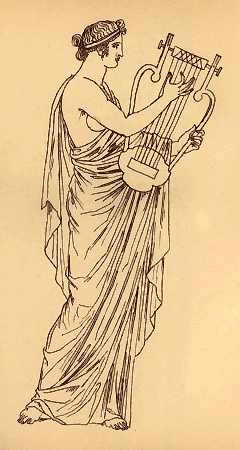ERATO (AIR-uh-toh)
Greek
Muse of lyric and love poetry
Common
clues:
Muse
of poetry; Muse with a lyre; Poet's inspiration; Sappho's muse;
Sister of Clio; Sister of Calliope; Daughter of Zeus; Lyric muse;
One of nine sisters
Crossword
puzzle frequency:
8 times a year
Frequency
in English language:
50552 / 86800
Video: The
Mask and the Muse
Erato (passionate) was the Greek Muse of lyric and love poetry. She was the most famous of the Muses. She is usually depicted holding a lyre and wearing a crown of roses.

In
Greek mythology, the Muses (Greek Μουσαι,
Mousai)
are nine archaic goddesses who embody the right evocation of myth,
inspired through remembered and improvised song and traditional
music and dances.
They were water nymphs, associated with the springs of Helicon and
Pieris. The Olympian system set Apollo as their leader, Apollon
Mousagetes.
According to Hesiod's Theogony, they are the daughters of Zeus, king of the gods, and Mnemosyne, goddess of memory. For Alcman and Mimnermus, they were even more primordial, springing from Uranus and Gaia.
Compare the Roman inspiring nymphs of springs, the Camenae.
According to Pausanias there were three original Muses: Aoide ("song", "voice"), Melete ("practice" or "occasion") and Mneme ("memory") (Paus. 9.29.1). Together, they form the complete picture of the preconditions of poetic art in cult practice.
The canonical nine Muses are:
Euterpe (music)
Calliope (epic poetry)
Clio (history)
Erato (lyric poetry)
Melpomene (tragedy)
Polyhymnia (sacred poetry)
Terpsichore (dancing)
Thalia (comedy)
Urania (astronomy)
Together, they form a complete picture of the subjects proper to poetic art in the archaic period. However, the association of specific muses with specific art forms is a later innovation, and has been called pedantic.
In Roman, Renaissance and Neoclassical art, Muses depicted in sculptures or paintings are often distinguished by certain props or poses, as emblems. Euterpe (music) carries a flute; Calliope (epic poetry) carries a writing tablet; Clio (history) carries a scroll and books; Erato (lyric poetry) is often seen with a lyre and a crown of roses; Melpomene (tragedy) is often seen with a tragic mask; Polyhymnia (sacred poetry) is often seen with a pensive expression; Terpsichore (dancing) is often seen dancing and carrying a lyre; Thalia (comedy) is often seen with a comic mask; and Urania (astronomy) carries a staff pointed at a celestial globe.
The muses are typically invoked at or near the beginning of an epic poem or story. They have served as aid to an author, or as the true speaker for which an author is only a mouthpiece. Originally the invocation of the Muse was an indication that the speaker was working inside the poetic tradition, according to the established formulae.
Two classic examples: Homer, Book I of the Odyssey:
"Tell me, O Muse, of that ingenious hero
who travelled far and wide
after he had sacked the famous town of Troy."
... And Dante Alighieri, in Canto II of the Inferno:
O Muses, o high genious, aid me now!
O memory that noted what I saw,
Now shall your true nobility be seen!
This article is licensed under the GNU Free Documentation License. It uses material from the Wikipedia article "Muse".
|
|